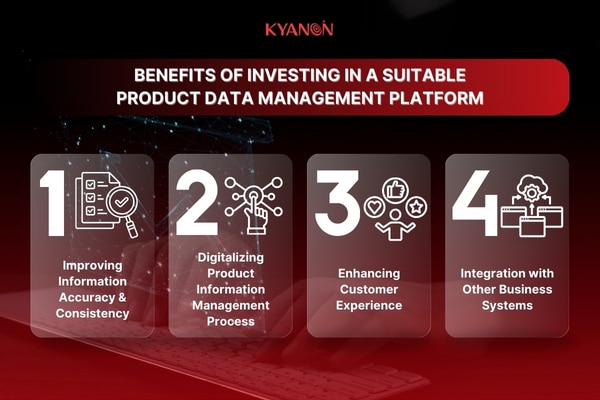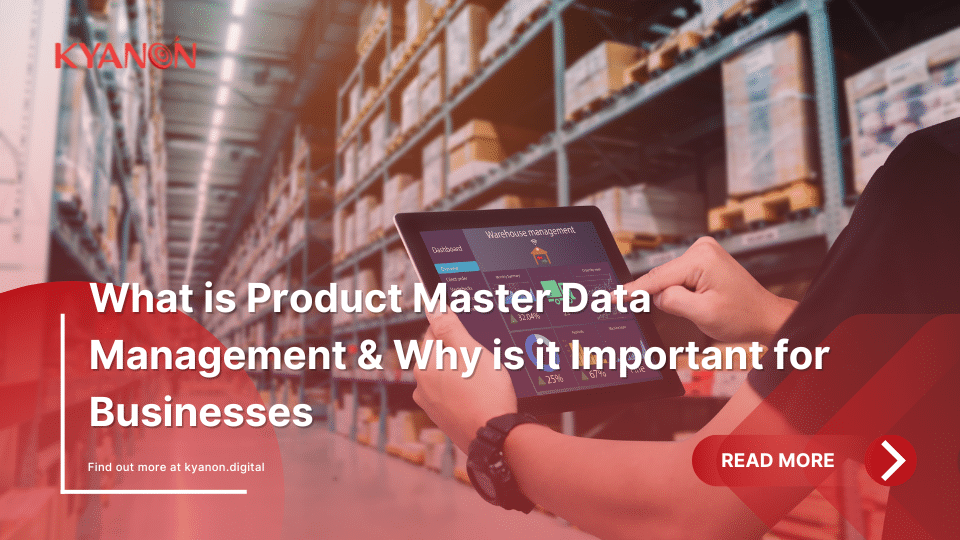In today’s fast-paced business landscape, where data is king, having accurate, consistent, and up-to-date product information is paramount. This is where Product Master Data Management comes into play. Product Master Data Management is a strategic approach to centralizing, managing, and governing product data across an organization.
Let’s Kyanon Digital walk you through the world of Product Master Data Management and explore reasons why it is important for businesses.
1. What is Product Master Data Management?
Product Master Data Management (MDM) is a collection of processes and technologies designed to consolidate data from various channels and sources into a “single source of truth.”
A product’s overall data management system is a centralized repository for all product-related data, including attributes, specifications, pricing, images, and descriptions. Master data management provides a single, reliable source of information (single source of truth), enabling businesses to gain a comprehensive view of their products and make informed decisions.
Product master data management involves utilizing powerful data management technologies, such as:
- Master data management software
- Data integration software
- Data governance solutions
- Data quality tools
These tools help clean, standardize, and enrich product data, ensuring its accuracy and relevance.
By implementing product data management, businesses can break down data silos, eliminate duplicate and inconsistent information, and establish a reliable foundation for data-driven business initiatives.
2. Importance of Product Information Management
Product information management plays a critical role in organizations across various industries. This activity ensures the accuracy, consistency, and accessibility of data, which are key factors driving business growth and success.
One of the main reasons why businesses implement master data management is to improve data quality and integrity.
Inaccurate and inconsistent product data can lead to costly errors, such as incorrect pricing, technical specifications, and misleading descriptions. These errors can lead to customer dissatisfaction, lost revenue, and damage to brand reputation.
Companies can ensure that their product data is accurate, complete, and up-to-date by implementing product management. This helps build customer trust, improve the overall experience, and increase their loyalty to the brand.
Additionally, master data management allows organizations to streamline product information management processes. Companies can easily update, modify, and distribute information across various systems and channels with a centralized repository for all product data.
Streamlining these processes helps reduce manual efforts, increase efficiency, and accelerate the time-to-market for new products.
Furthermore, good product information management enables related departments to collaborate seamlessly, eliminating confusion and misinformation. This collaboration enhances productivity, speeds up decision-making, and improves the unit’s or business’s overall effectiveness.
When it comes to product information management, businesses need to recognize that many different types of information need to be processed, such as:
- Product Attributes
- Product specifications
- Pricing information
- Inventory
Each value is crucial in providing accurate and relevant product information to customers.
Some critical types of product data that businesses should focus on managing include:
- Product Attributes: including details such as size, color, weight, and other distinguishing features of the product.
- Product Specifications: providing information about materials, dimensions, features, and technical specifications of the product.
- Pricing Information: tracking list prices, discounts, promotions, and price fluctuations across different product channels.
- Images and Descriptions: visual content and textual descriptions that provide detailed information about a product, including its features, benefits, and specifications.
- Availability and Inventory: ensuring accurate information regarding stock levels and product availability.
- Compliance and Regulatory Data: certifications, standards, and legal requirements related to the products.
- Relationships and Associations: tracking related products, cross-selling, up-selling, and building supportive relationships.
- Customer Reviews and Ratings: collecting customers’ feedback and ratings for each product.
- Sales and Performance Data: recording sales data, revenue, and product sales performance for analysis and long-term decision-making
- Historical Data: tracking changes and product updates over time
- Localization and Translation Data: providing translated content and digital information for global markets.
Organizations can optimize operations and provide seamless customer experiences by effectively managing these types of product data.
Transform your ideas into reality with our services. Get started today!
Our team will contact you within 24 hours.
3. Common Challenges in implementing Product Data Management
Alongside the benefits that product information data management brings, businesses also face unique challenges when implementing and maintaining such systems. Below are some common challenges organizations and enterprises encounter in managing product data effectively.

Common Challenges in implementing Product Data Management
3.1. Data Complexity
Product data can be diverse and intricate, encompassing numerous attributes, classifications, and hierarchies. Managing this complexity requires a robust data management system capable of handling various types of product information.
3.2. Integration Difficulties
Organizations often struggle to integrate product data from multiple sources, such as:
- Enterprise Resource Planning (ERP) systems
- Customer Relationship Management (CRM) software
- E-commerce platforms
Ensuring seamless integration and data synchronization is crucial for maintaining accuracy and consistency.
3.3. Lack of Data Governance
Data governance policies and procedures are essential for preserving data quality and security. However, organizations often find defining and consistently implementing these policies across the entire system is challenging.
3.4. Data Maintenance
Keeping product data up-to-date and relevant is an ongoing challenge. Products undergo frequent changes, necessitating regular updates to technical specifications and pricing. Managing these changes and ensuring data accuracy requires dedicated resources and efficient processes.
3.5. Data Security
Protecting product data from unauthorized access and maintaining data security is paramount for businesses and organizations. Implementing robust security measures and complying with data protection regulations like GDPR are significant challenges in product data management.
4. Benefits of Investing in a Suitable Product Data Management Platform
Overcoming these challenges, organizations will reap numerous benefits from product data management.

Benefits of Investing in a Suitable Product Data Management Platform
4.1. Improving Information Accuracy and Consistency
One of the benefits of implementing product master data management is enhancing information accuracy and consistency.
By centralizing product information and establishing data governance policies, businesses can ensure that product information is accurate, up-to-date, and consistent across all systems and sales channels.
Organizations can avoid errors such as incorrect pricing or product descriptions by storing reliable product information. This builds customer trust and enhances their experience, reducing the likelihood of returns and complaints and ultimately increasing customer satisfaction and loyalty.
4.2. Digitalizing Product Information Management Process
Another significant advantage of master data management is streamlining the product information management process. With a centralized repository for product information, organizations can easily update, modify, and distribute information across multiple systems and sales channels.
Streamlining these processes eliminates the need for manual data entry and reduces the risk of errors associated with manual data handling. Additionally, it shortens the time to market for new products for product information to be quickly updated and distributed across all relevant channels.
By streamlining the product information management process, businesses can operate more efficiently, improve overall productivity, focus on core business activities, and drive innovation.
4.3. Enhancing Customer Experience
Implementing product master data management can significantly improve operational efficiency and reduce organizational costs by eliminating redundant and inconsistent information. As a result, organizations and businesses can save time and effort spent on manual data correction and reconciliation.
Product information management software enables organizations to automate information management processes, such as data integration, cleansing, and enrichment. This automation reduces manual effort and minimizes human error, increasing efficiency and productivity.
Furthermore, with accurate and up-to-date product information, organizations can optimize inventory management, pricing strategies, and supply chain operations. This optimization helps reduce costs, lower inventory holding costs, and improve operational efficiency.
4.4. Integration with Other Business Systems
Using specialized data integration tools, product master data management systems can seamlessly integrate with other business systems such as ERP and CRM software. This integration enables seamless information exchange between systems, ensuring consistency and accessibility of information.
Integrating with other business systems allows organizations to quickly analyze data and gain deep customer insights across different business systems. This enables the formation and development of marketing and promotional campaigns targeted at specific customer segments.
In today’s business landscape, comprehensive product information management is crucial, especially for organizations seeking a competitive edge. Leveraging master data management requires accurate and consistent information to drive customer satisfaction and achieve sustainable growth.
—–
Implementing a robust Product Master Data Management strategy requires careful planning and execution. While the benefits are significant, the process can be complex without the right expertise. This is where Kyanon Digital can be a valuable partner.
As a leading technology solutions provider, Kyanon Digital offers a comprehensive suite of services to help businesses achieve their master data management goals. Contact Kyanon Digital today to get consultancy from the experts.

















